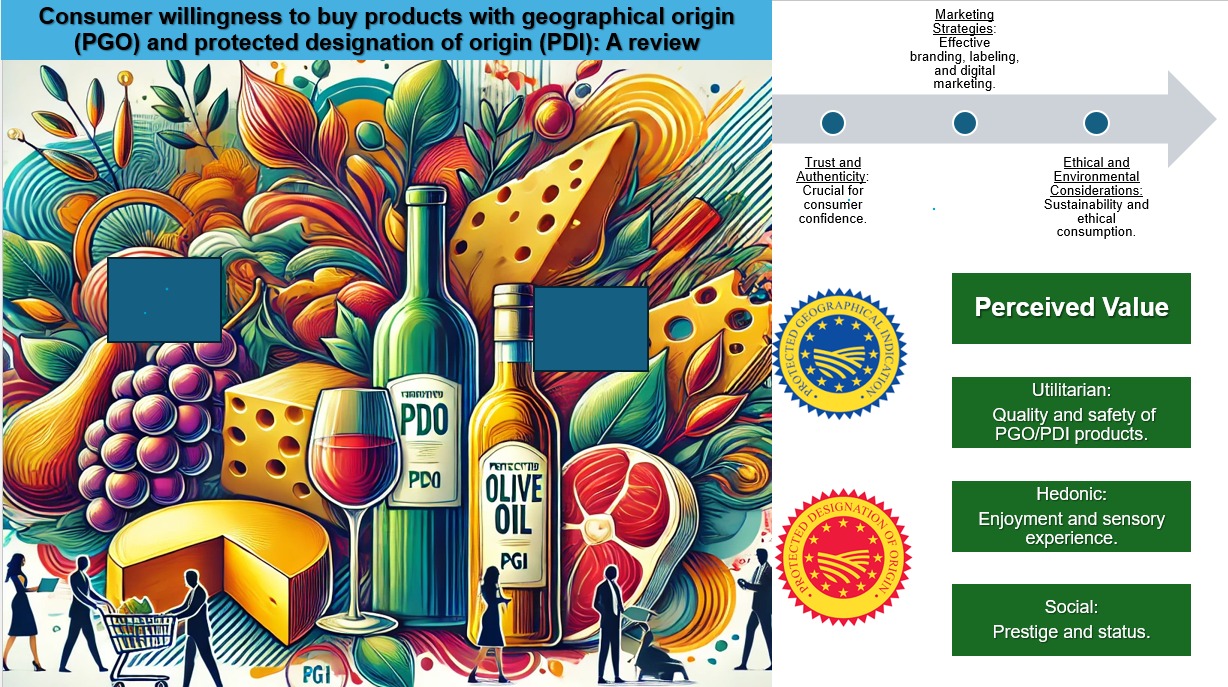Consumer willingness to buy products with geographical origin (PGO) and protected designation of origin (PDI): A review
DOI:
https://doi.org/10.14295/bjs.v3i10.620Keywords:
consumers, willingness, products with geographical origin, protected designation of originAbstract
This scientific review explores the factors influencing consumer willingness to purchase products with geographical origin (PGO) and protected designation of origin (PDI) over the past twenty-five years. It examines consumer behavior, perceived value, marketing strategies, and the impacts of ethical and environmental considerations and more specifically how the consumers are willing to consume products from protected designation of origin compared with the other products that exist in markets. The review integrates findings from recent peer-reviewed studies, surveys, and reports, offering a comprehensive analysis of consumer attitudes toward PGO/PDI products. In conclusion, the consumers are willing to buy the PGO and PDI products if there is a better price and marketing presentation.
References
Bimbo, F., Bonanno, A., Viscecchia, R., & Nardone, G. (2020). Sustainability and consumer willingness to pay for multi-ingredient, processed organic food products. Food Policy, 32, 145-159. DOI: https://doi.org/10.1016/j.foodpol.2006.05.003
Bonett, C., & Simioni, M. (2001). Assessing consumer response to protected designation of origin labeling: A mixed logit approach. European Review of Agricultural Economics, 28(4), 433-449. https://doi.org/10.1093/erae/28.4.433 DOI: https://doi.org/10.1093/erae/28.4.433
Bouhaddane M, Halawany-Darson R, Rochette C, Amblard C. (2023). Legitimate or not, does it really matter? A reading of the PDO label's legitimacy through consumers' perception. Foods, 12(12), 2365. https://doi.org/10.3390/foods12122365 DOI: https://doi.org/10.3390/foods12122365
Brouwer, O. (1991). Community protection of geographic indications and specific character as a means of enhancing foodstuff quality. Law Review, 28, 615-646. DOI: https://doi.org/10.54648/COLA1991035
Dawar, N., & Frost, T. (1999). Competing with giants; Survival strategies for local companies in emerging markets. Harvard Business Review, 77(2), 119-129.
Espejel, J., Fandos, C., & Flavián, C. (2009). The influence of consumer degree of knowledge on consumer behaviour: The case of Spanish olive oil. Journal of Food Products Marketing, 15(1), 15-37. https://doi.org/10.1080/10454440802470565 DOI: https://doi.org/10.1080/10454440802470565
Grossman, G. M., & Shapiro, C. (1988). Foreign counterfeiting of status goods. Quarterly Journal of Economics, 103(1), 79-100. https://doi.org/10.2307/1882643 DOI: https://doi.org/10.2307/1882643
Hassan, D., & Monier-Dihlan, S. (2002). Signes de qualité et qualité des signes: Une application au marché du camembert. Cahiers d’ Economie et Sociologie Rurales, 65, 10-20. https://hal.science/hal-01201007 DOI: https://doi.org/10.3406/reae.2002.1694
Haucap, J., Wey, C., & Barmbold, J. F. (1997). Location choice as a signal for product quality: The economics of “Made in Germany”. Journal of Institutional and Theoretical Economics, 153(3), 510-531. https://www.jstor.org/stable/40752001
Herrera, C. F., & Blanko, C. F. (2011). Consequences of consumer trust in PDO food products: The role of familiarity. Journal of Product and Brand Management, 20(4), 282-296. https://doi.org/10.1108/10610421111148306 DOI: https://doi.org/10.1108/10610421111148306
Josling, T. (2006). The war on terroir: Geographical indicators as a transatlantic trade conflict. Journal of Agricultural Economics, 57(3), 337-364. https://doi.org/10.1111/j.1477-9552.2006.00075.x DOI: https://doi.org/10.1111/j.1477-9552.2006.00075.x
Keller, K. L. (2003). Strategic Brand Management; Building, Measuring, and Managing Brand Equity (Upper Saddle River, NJ: Prentice Hall).
Landon, S., & Smith, C. E. (1998). Quality expectations, reputation, an price. Southern Economic Journal, 64(3), 628-647. https://doi.org/10.1002/j.2325-8012.1998.tb00084.x DOI: https://doi.org/10.1002/j.2325-8012.1998.tb00084.x
Maina, F. W., Mburu, J., Ackello-Ogutu, C., & Egelyng, H. (2019). Producers' valuation of geographical indications-related attributes of agri-food products from semi-arid lands in Kenya. Heliyon, 5(2), e01218. https://doi.org/10.1016/j.heliyon.2019.e01218 DOI: https://doi.org/10.1016/j.heliyon.2019.e01218
Oliver, R. L. (1999). Whence consumer loyalty?. Journal of Marketing, 63(4), 33-44. https://doi.org/10.1177/00222429990634s105 DOI: https://doi.org/10.1177/00222429990634s105
Pinto, A. S., Barreiro, G., Fragata, A., Combris, P., & Giraud-Heraud, E. (2008). Quality attributes of “Rocha” pear and consumer behaviour: Sensory evaluation and willingness to pay. Acta Horticulturae 800(2), 1005-1012. https://doi.org/10.17660/ActaHortic.2008.800.137 DOI: https://doi.org/10.17660/ActaHortic.2008.800.137
Schirone, M., Vergara, A., D’Annunzio, T., & Ianieri, A. (2007). Evolution of European Union regulation concerning DOR IGP and STG products. Industrie Alimentari, 46(474), 1125-1133.
Steiner, B. (2004). French wines on the decline? Econometric evidence from Britain. Journal of Agricultural Economics, 55(2), 267-288. https://doi.org/10.1111/j.1477-9552.2004.tb00096.x DOI: https://doi.org/10.1111/j.1477-9552.2004.tb00096.x
Teuber, R., & Dolgopolova, I. (2018). Consumers' willingness to pay for geographical origin labels: The case of Russia. Journal of Agricultural Economics, 69(3), 739-759. https://doi.org/10.23751/pn.v25i2.13380
Van der Lans, I. A., Van Ittersum, K., De Cicco, A., & Loseby, M. (2001).The role of the region of origin and EU certificates of origin in consumer evaluation of food products. European Review of Agricultural Economics,28(4), 451-477. https://doi.org/10.1093/erae/28.4.451 DOI: https://doi.org/10.1093/erae/28.4.451
Van Ittersum, K., Meulenberg, M., Trijp, H., & Candee, M. (2007). Consumer appreciation of regional certification labels: A Pan-European study. Journal of Agricultural Economics, 58(1), 1-23. https://doi.org/10.1111/j.1477-9552.2007.00080.x DOI: https://doi.org/10.1111/j.1477-9552.2007.00080.x
Verlegh, P. W. J., & Steenkamp, J. -B. E. M. (1999). A review and meta-analysis of country of- origin research. Journal of Economic Psychology, 20(5), 521-546. https://doi.org/10.1016/S0167-4870(99)00023-9 DOI: https://doi.org/10.1016/S0167-4870(99)00023-9
Winfree, J. A., & McCluskey, J. J. (2005). Collective reputation and quality. American Journal of Agricultural Economics, 87(1), 206-213. https://doi.org/10.1111/j.0002-9092.2005.00712.x DOI: https://doi.org/10.1111/j.0002-9092.2005.00712.x
Wu, Y., & Huang, H. (2023). Influence of perceived value on consumers’ continuous purchase intention in live-streaming E-commerce—Mediated by Consumer Trust. Sustainability, 15(5), 4432. https://doi.org/10.3390/su15054432 DOI: https://doi.org/10.3390/su15054432

Downloads
Published
How to Cite
Issue
Section
License
Copyright (c) 2024 Marianna Foteini Dafni, Zisimos Likudis

This work is licensed under a Creative Commons Attribution 4.0 International License.
Authors who publish with this journal agree to the following terms:
1) Authors retain copyright and grant the journal right of first publication with the work simultaneously licensed under a Creative Commons Attribution License that allows others to share the work with an acknowledgement of the work's authorship and initial publication in this journal.
2) Authors are able to enter into separate, additional contractual arrangements for the non-exclusive distribution of the journal's published version of the work (e.g., post it to an institutional repository or publish it in a book), with an acknowledgement of its initial publication in this journal.
3) Authors are permitted and encouraged to post their work online (e.g., in institutional repositories or on their website) prior to and during the submission process, as it can lead to productive exchanges, as well as earlier and greater citation of published work.



